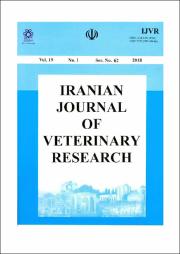3-D computed tomography reconstruction: another tool to teach anatomy in the veterinary colleges
(ندگان)پدیدآور
Jaber Mohamad, JoséCarrascosa, C.Arencibia, A.Corbera, J. A.Ramirez, A. S.Melian, C.نوع مدرک
TextLetter to editor
زبان مدرک
Englishچکیده
This letter underpins the use of three-dimensional computed tomography (3D-CT) reconstruction as an aid to teach veterinary anatomy. Cases were presented to students in order to observe normal and clinically abnormal patients. The images provided excellent details of relevant structures and could serve as a tool for teaching anatomy. Many sources describe different options to enhance anatomical learning by students through the use of modern imaging techniques such as computed tomography (CT) or magnetic resonance (MR) imaging. The contribution of CT to anatomical knowledge is limited due to the high cost and the lack of a suitable design for large animals, although recently studies have been reported on foals head (Cabrera et al., 2015). Advances in CT studies involve the generation of 3D-CT of the canine spine (Drees et al., 2009), the sea lion head (Dennison and Schwarz, 2008), or orbital diseases (Zafra et al., 2012). This study reports examples of this technique and its contribution to the understanding by the students. The CT images were obtained at the Veterinary Hospital of Las Palmas University from different cases. Transverse images were obtained using fourth generation CT equipment. Each patient was subjected to 3D reconstruction using a standard DICOM 3D format. The images were showed to a group of 20 students that had completed their basic training by learning anatomy through computer simulations. They could label relevant structures of the cervical spine of foal, including the atlas and its occipital articulation and the modified spinous process of axis (Fig. 1). In relation to the dog head, the 3D-CT showed the extent of the bony lesions, occupying the orbital region. It affected the maxillary border of the zygomatic and frontal bone (Fig. 2). In the last case, students visualized fractures of the dogskull. Additional transverse image showed contusional hemorrhage in the left parietal lobe and dilatation of lateral ventricles (Fig. 3).
شماره نشریه
1تاریخ نشر
2018-03-011396-12-10
ناشر
Shiraz Universityمعاونت پژوهشی دانشگاه شیراز
سازمان پدید آورنده
Department of Morphology, Faculty of Veterinary Medicine, Universidad de Las Palmas de Gran Canaria, SpainDepartment of Pathology and Food Technology, Faculty of Veterinary Medicine, Universidad de Las Palmas de Gran Canaria, Spain
Department of Morphology, Faculty of Veterinary Medicine, Universidad de Las Palmas de Gran Canaria, Spain
Department of Pathology and Food Technology, Faculty of Veterinary Medicine, Universidad de Las Palmas de Gran Canaria, Spain
Department of Pathology and Food Technology, Faculty of Veterinary Medicine, Universidad de Las Palmas de Gran Canaria, Spain
Department of Pathology and Food Technology, Faculty of Veterinary Medicine, Universidad de Las Palmas de Gran Canaria, Spain
شاپا
1728-19972252-0589





